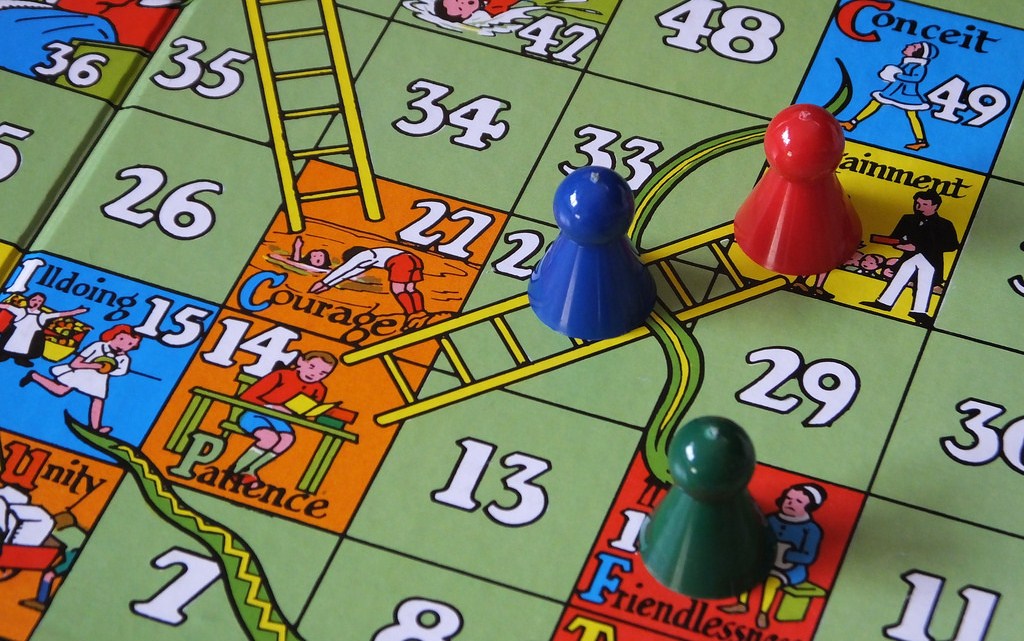03 May 2018
Snakes and Ladders
World leaders throw the dice.
By Neil Tidmarsh
 Well, at least Chancellor Merkel got a handshake from President Trump, which is more than she managed a year ago when they last met. And if she only had barely three hours with Mr Trump, compared to President Macron’s three days, it seems that the French president didn’t achieve much more than she did; he admitted this week that it’s unlikely that he changed Trump’s mind about the Iran deal. In fact, President Trump was claiming that he had changed Macron’s mind about it.
Well, at least Chancellor Merkel got a handshake from President Trump, which is more than she managed a year ago when they last met. And if she only had barely three hours with Mr Trump, compared to President Macron’s three days, it seems that the French president didn’t achieve much more than she did; he admitted this week that it’s unlikely that he changed Trump’s mind about the Iran deal. In fact, President Trump was claiming that he had changed Macron’s mind about it.
And so the world’s leaders continued their game of Snakes and Ladders this week – snakes plunging us down towards Armageddon, ladders hauling us up towards World Peace.
If Mrs Merkel’s trip to Washington didn’t land us on a ladder any more than Mr Macron’s did, then another meeting on the same day but on the other side of the world more than made up for it. President Moon of South Korea stepped over the border into North Korea; Kim Jong-un of North Korea stepped over the border into South Korea. Their throw of the dice promises to land us on a whole range of extendable ladders, firefighter’s ladders at that. Together they vowed to free the Korean peninsula of nuclear weapons. Kim said he’d begin dismantling the North’s nuclear facilities within a month, and invited international inspectors to come and watch him do it. And he even said that the North will return to the South’s time zone (he set the North’s clocks back thirty minutes three years ago). President Moon said that the South will take down the loudspeakers which have been blasting propaganda across the border into the North in recent years. “I’m confident that a new era of peace will open on the Korean peninsula,” he declared on his return to Seoul from the summit in the Peace House.
Other ladders appeared on this part of the board only a few days later:
Studies of seismic data by scientists from China, Europe and the USA suggest that North Korea’s nuclear test site at Punggye-ri, deep underground beneath the 7,200 foot Mount Mantap, has collapsed. It’s thought that the most recent test – a 250 kiloton blast, seventeen times that of the Hiroshima bomb, last September – caused a 6.3 magnitude earthquake, followed just under ten minutes later by a 4.1 magnitude tremor which, experts believe, was the test site collapsing. Further tests, even if possible, would probably make the whole mountain cave in on itself and leak radiation across the region and over the border into China. So perhaps Kim Jong-un’s new found enthusiasm for closing down his nuclear weapons programme isn’t such a mystery after all.
President Trump has finally got round to appointing a US ambassador to South Korea at last. Admiral Harry Harris, chief of the US Pacific fleet, will soon be installed as Washington’s man in Seoul. Mind you, he was on his way to Australia as US ambassador there, so the region will still be short of an American diplomat or two.
China confirmed that its foreign minister, Wang Yi, will visit Pyongyang later this week for a two day meeting with the North Korean foreign minister, Ri Yong-ho, at his invitation.
Inspired by the events in Korea, the president of Taiwan asked for a peace summit with China. President Tsai said that she “would be willing to do anything that is helpful for peace and stability” and would meet President Xi “without any political precondition and on an equal footing”. The two countries don’t recognise each other, and last month Beijing sent warships and fighter planes on manoeuvres through the straits separating them.
At least one snake, however, appeared alongside these ladders. Japan is anxious to have its voice heard in the Korean peace-process; North Korea has always been a threat to Japan and South Korea has historic grievances against Japan; any North/South rapprochement will inevitably alter the geopolitical balance in the region, not necessarily to Japan’s benefit. Although President Moon reported that Kim Jong-un wouldn’t object to Japan having a place in the proceedings, the sensitivity of the issue was emphasised by the pudding to be served at the banquet in the Peace House: advanced publicity showed pictures of the “Spring of the People” – a mango mousse with ice cream and flower petals – topped by a chocolate map of the Korean peninsula, a map which included the Dokdo Islets, a group of islands occupied by South Korea but claimed by Japan. Japan’s foreign ministry protested to the South Korean embassy in Tokyo, and the Japanese government asked for the desserts not to be served. Kim Jong-un is known to enjoy his food – he must have taken a dim view of any suggestion that a pudding might not be forthcoming.
There were snakes popping up this week in other areas of the board as well, namely (inevitably) in the Middle East:
With President Trump’s review of the Iran nuclear deal approaching (due on May 12), the prime minister of Israel, Binyamin Netanyahu, made an extraordinary presentation on live TV in a bid to encourage Trump to turn his back on the deal. Netanyahu revealed that a cache of 55,000 secret documents had been seized (presumably by Mossad) from a security facility in Tehran; these documents, he maintains, prove that Iran has been lying about its nuclear ambitions. Tehran has always maintained that it does not have and has never had any program for making nuclear weapons; Netanyahu’s revelation appears to prove that it did indeed have a nuclear weapons program. President Trump, continuing to attack the deal, was grateful for the support. However, the other signatories of the deal – the UK, France, Germany, China and Russia – were quick to point out that Netanyahu’s revelation didn’t prove that Iran has reneged on the deal, only that they had lied before it; if anything, the revelation seemed to suggest that the Iranian nuclear weapons program (no, no one was ever fooled by Tehran’s “Weapons programme? What weapons program? We’re only working towards nuclear energy…”) has indeed been moth-balled and Tehran is indeed observing the deal.
Israeli/Iranian conflict appeared to continue in Syria with military bases near Hama and Aleppo hit by airstrikes on April 30. Syria pointed the finger at Israel; Israel didn’t deny the accusations. The bases are said to be occupied by Iranian Revolutionary Guard, and to contain the headquarters of the Brigade 47 and a “scientific research centre” producing missiles. Conflicting reports said that up to 26 Iranian soldiers were killed.
Also in Syria, Russia has said that it will supply Assad’s forces with advanced S-300 surface-to-air missile systems, in response to the recent US-led strikes by Western airforces. This air defence system has a range of 200 miles and can hit up to six targets at once. The deployment of the system would escalate the consequences of any further Western air-strikes, and Israel has said that it would target the system if it’s used against its aircraft.
So, that’s what the board is looking like this week. Over in the White House, President Trump is reaching for the dice. Next week he’ll shake them and throw them – and on May 12 we’ll see where they fall.


